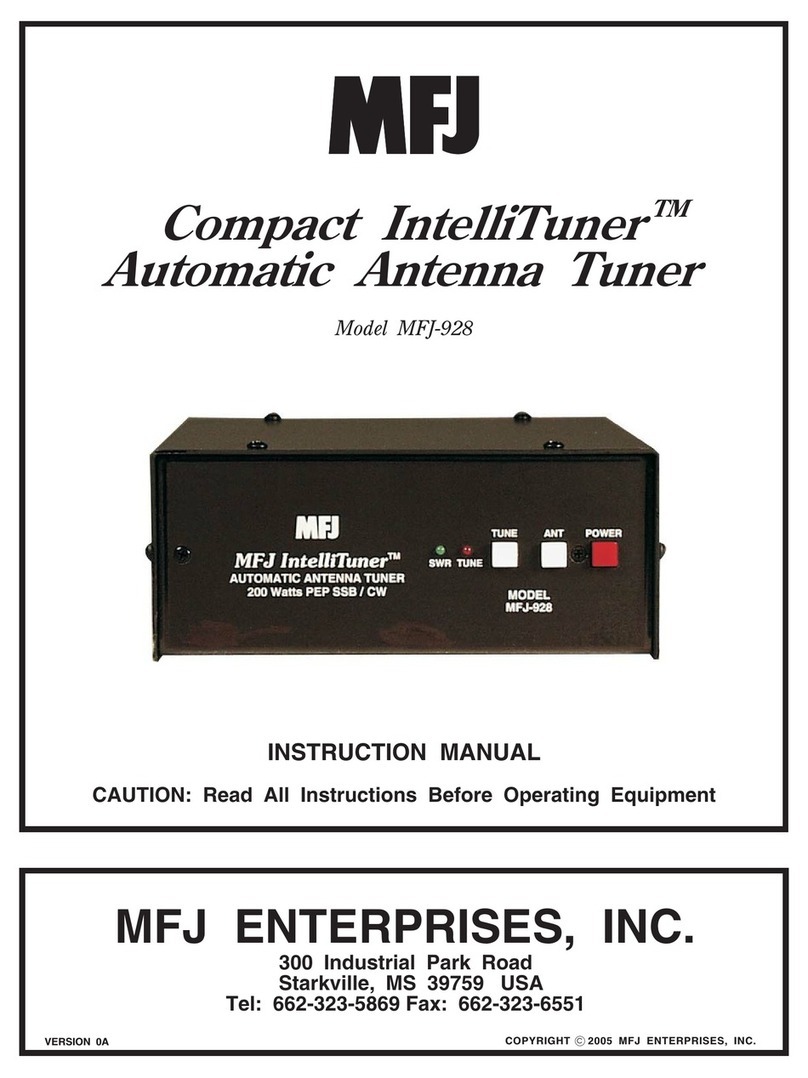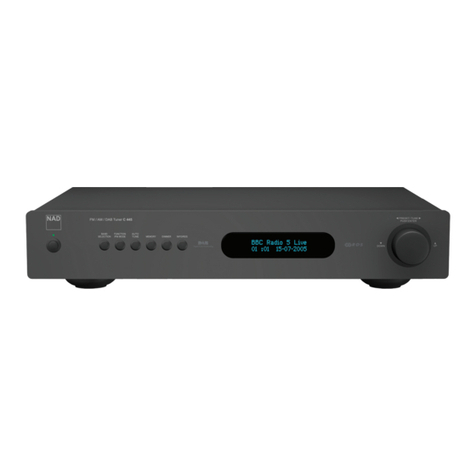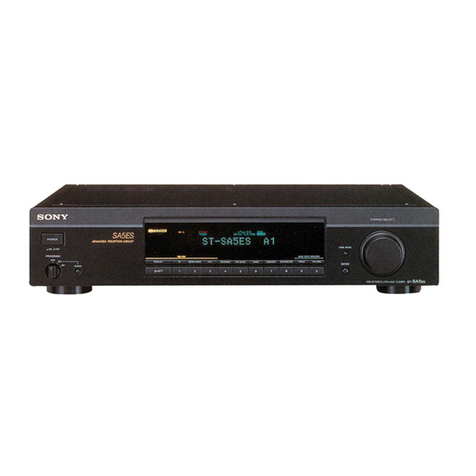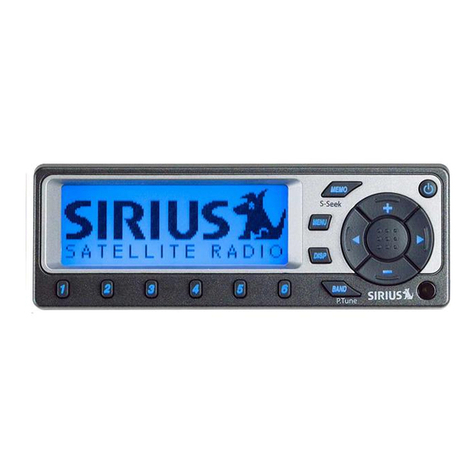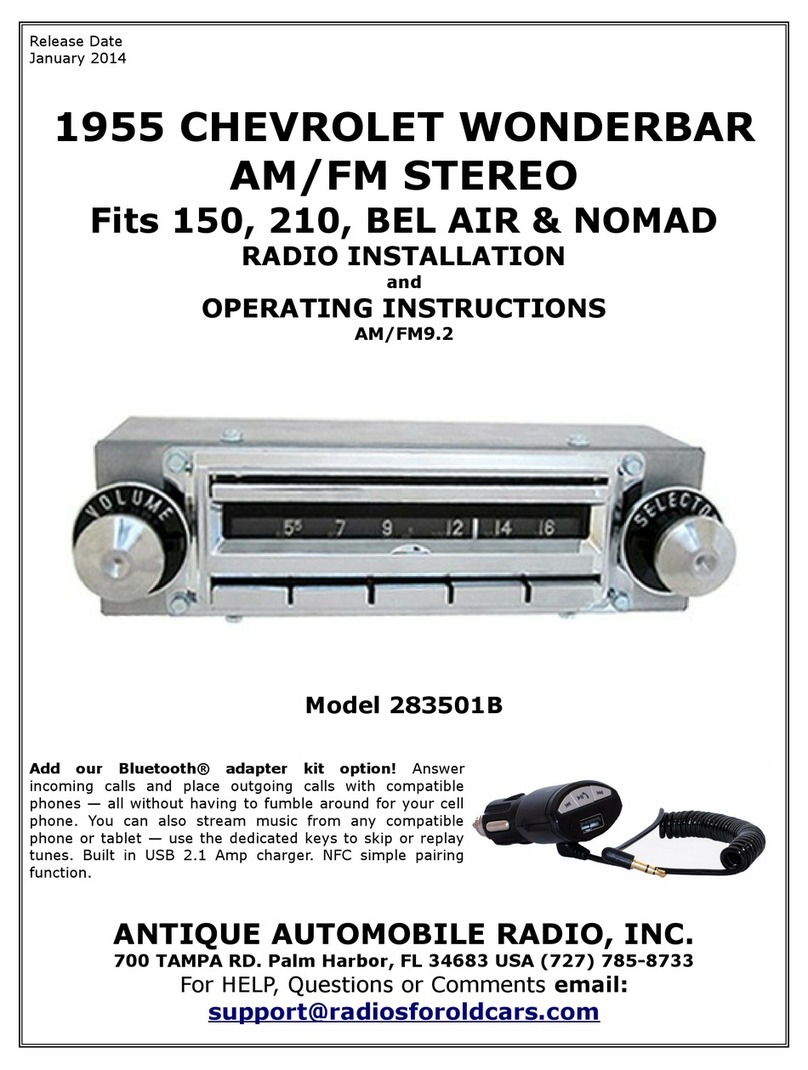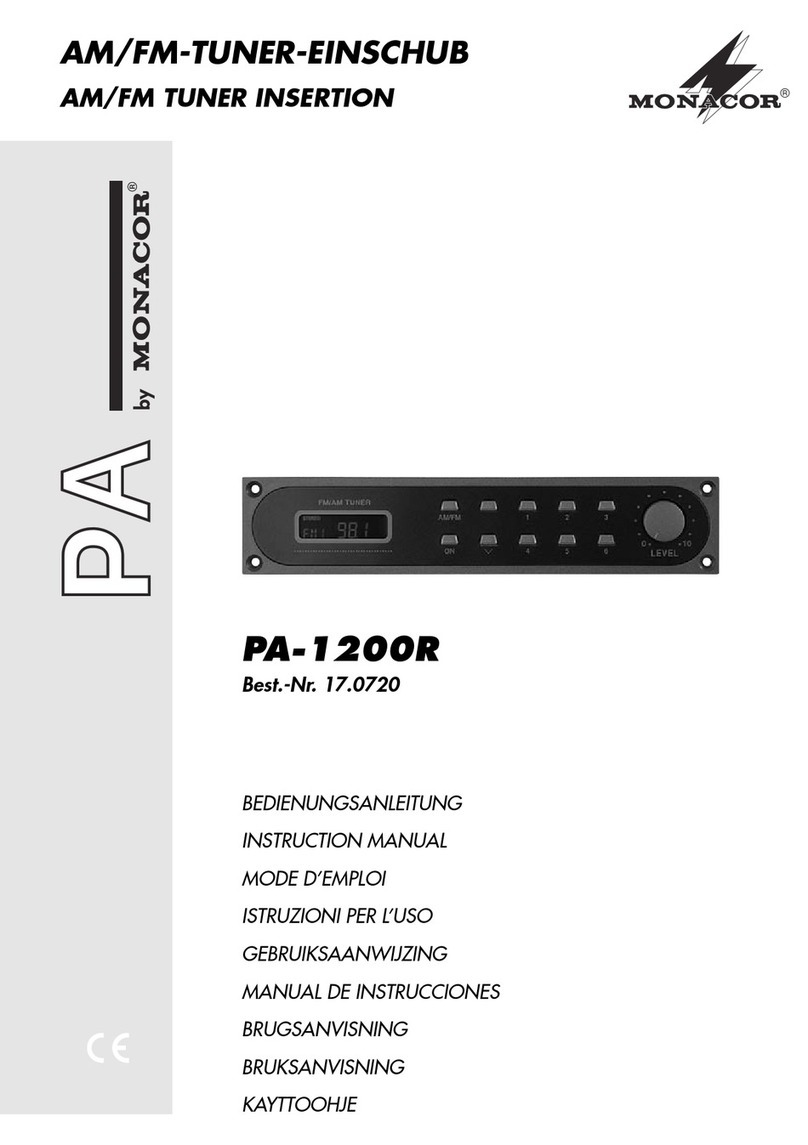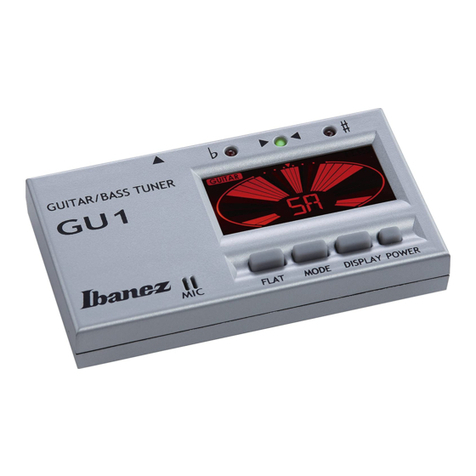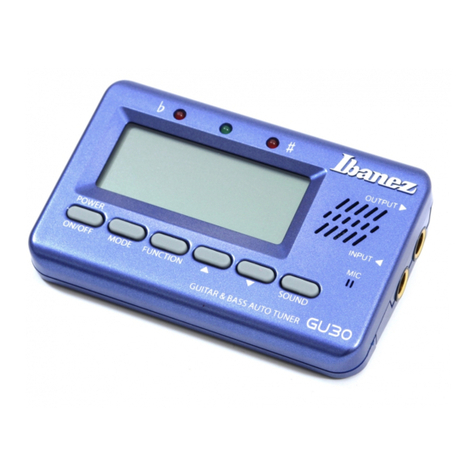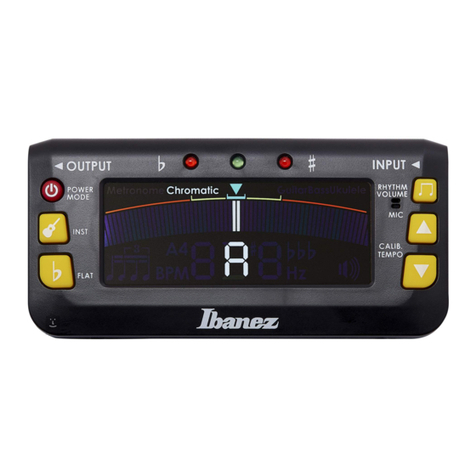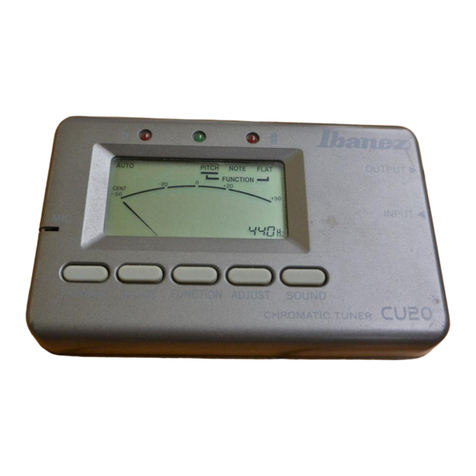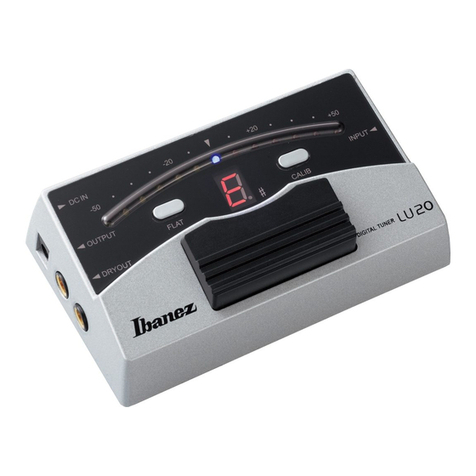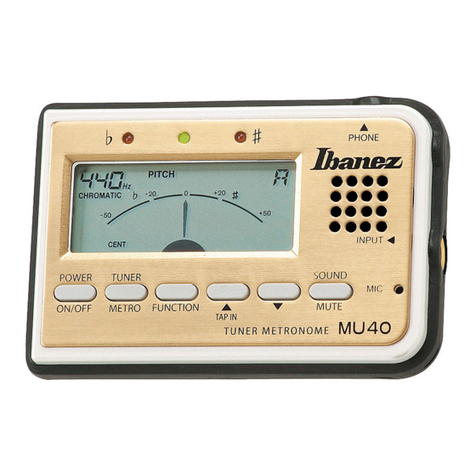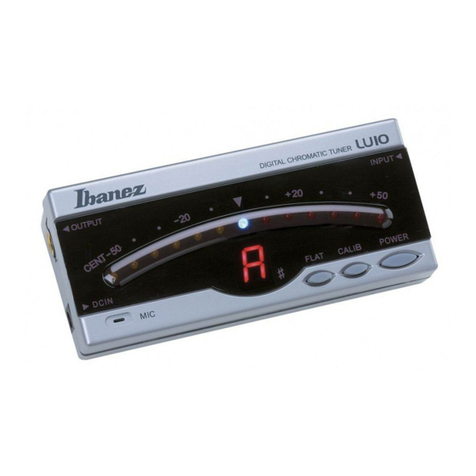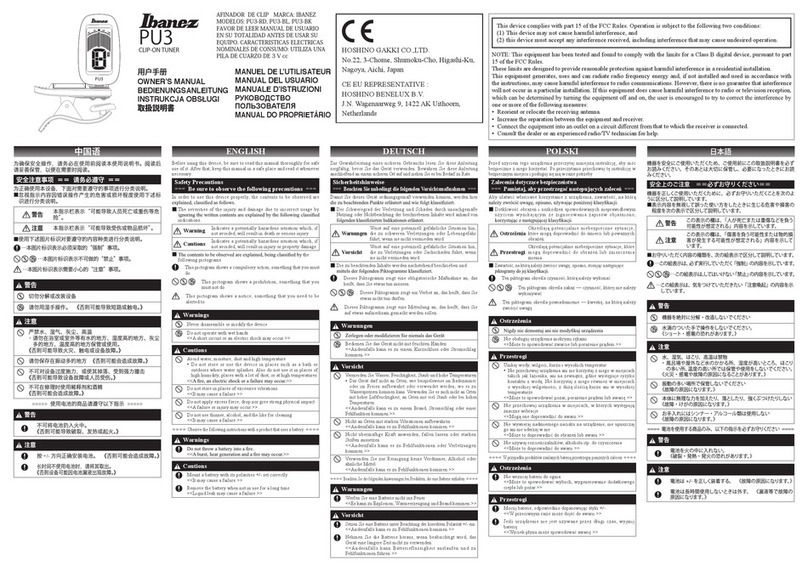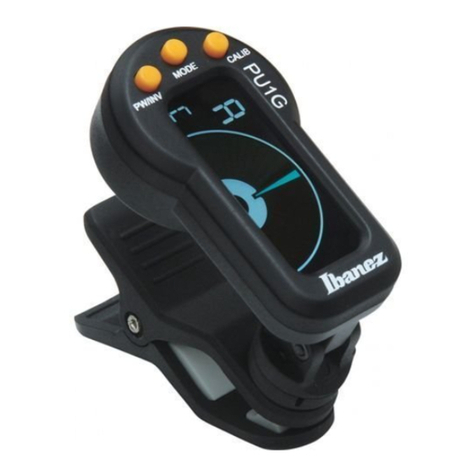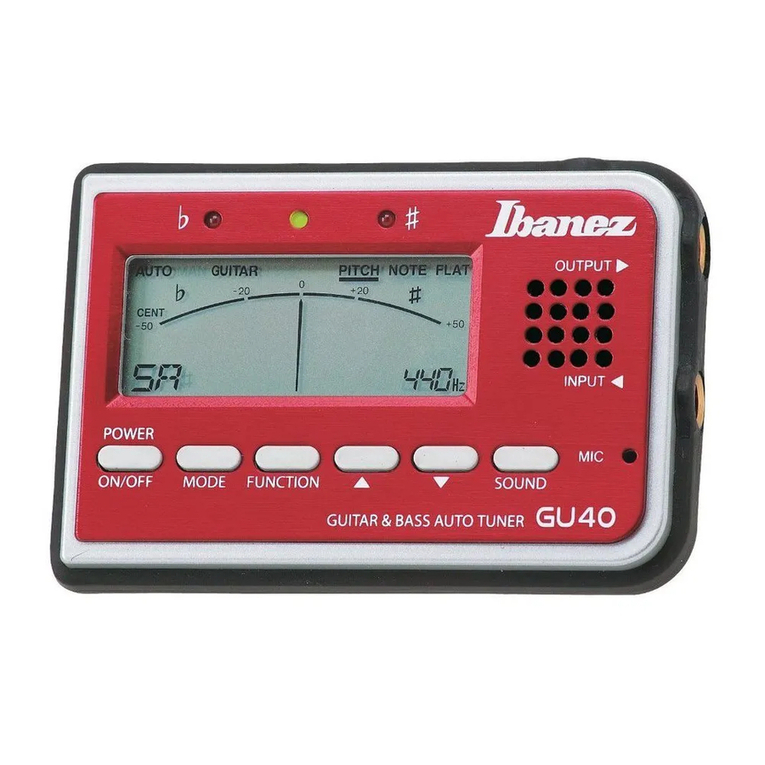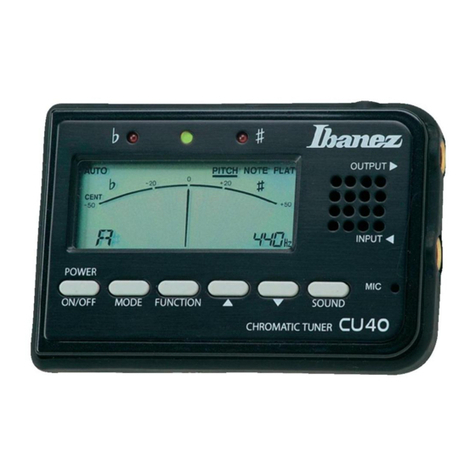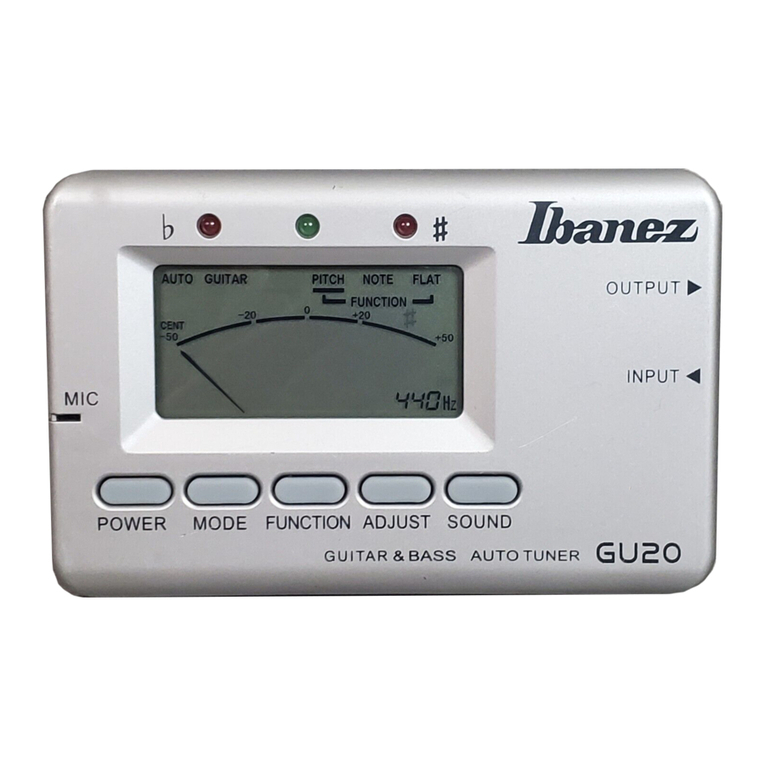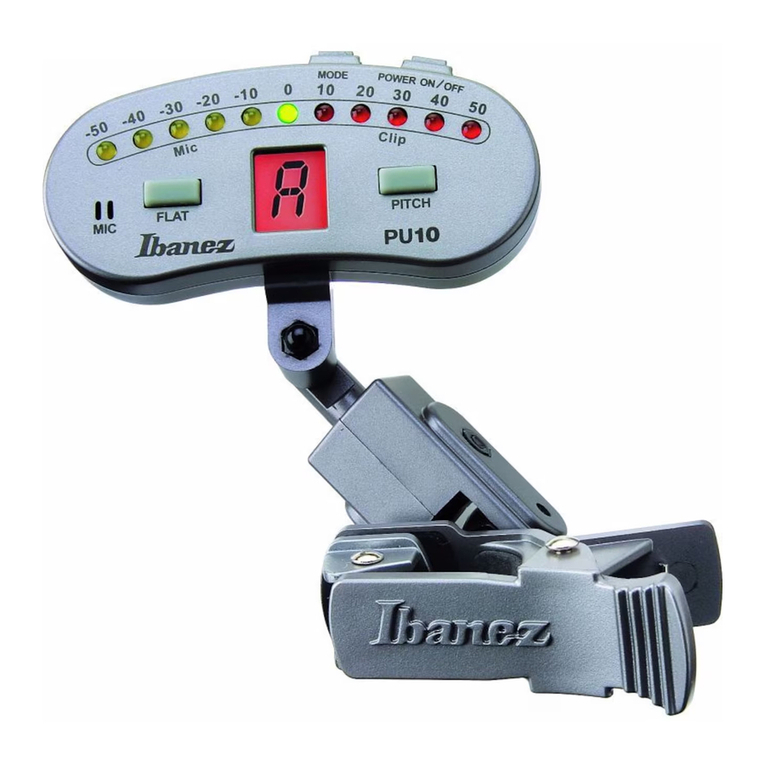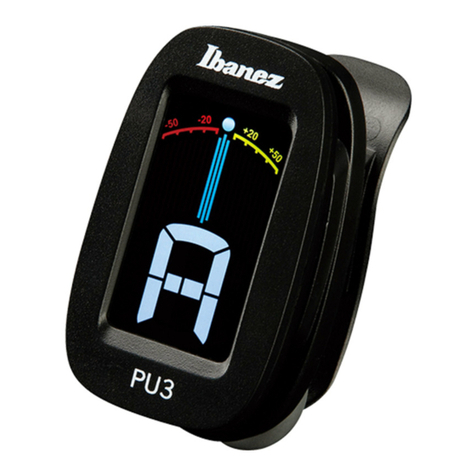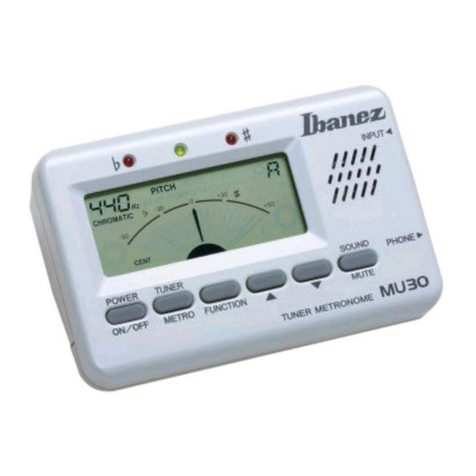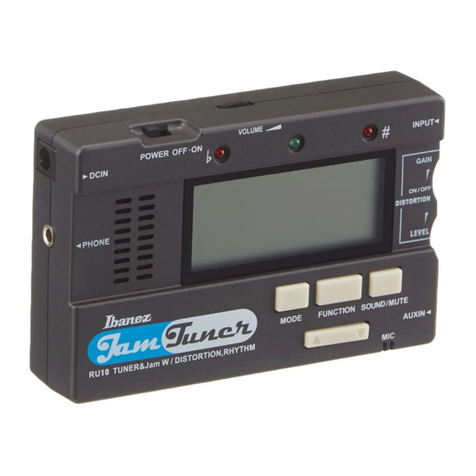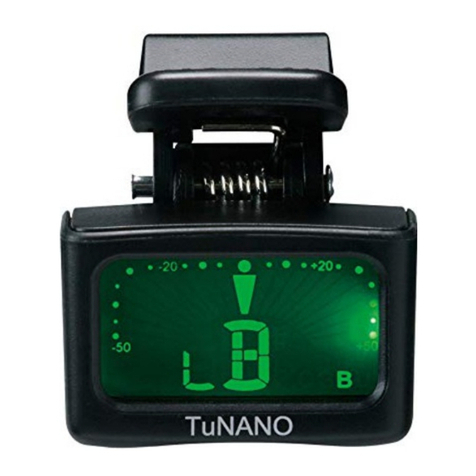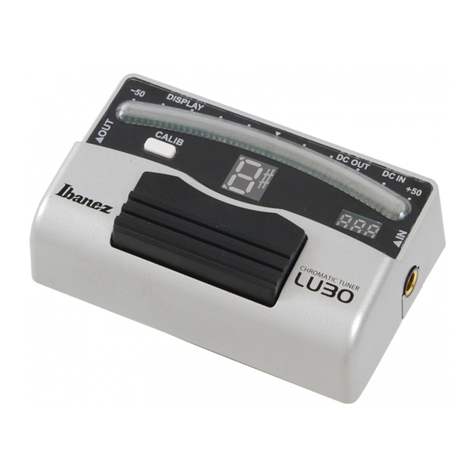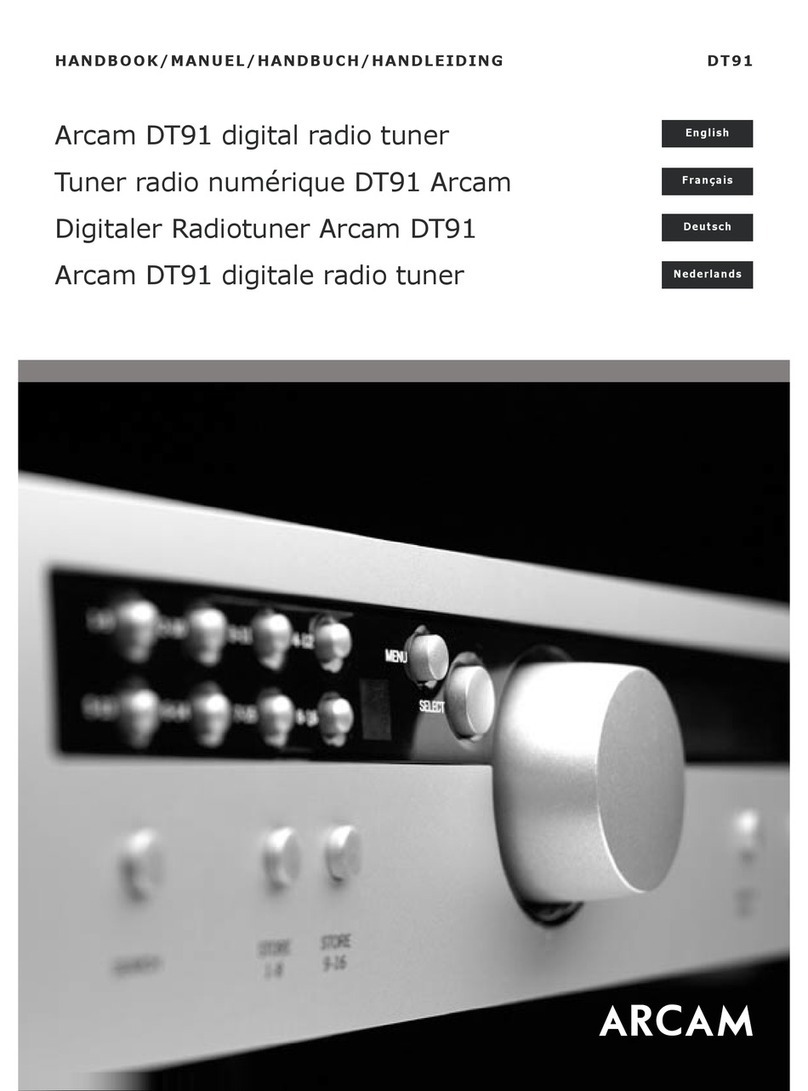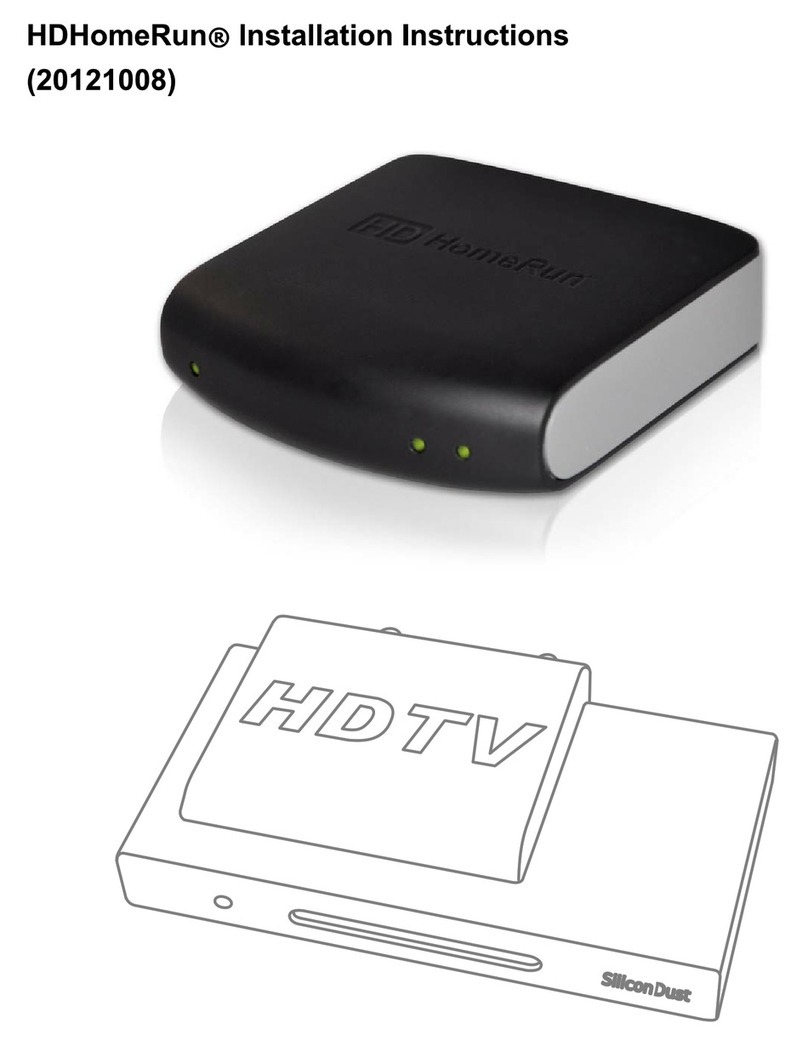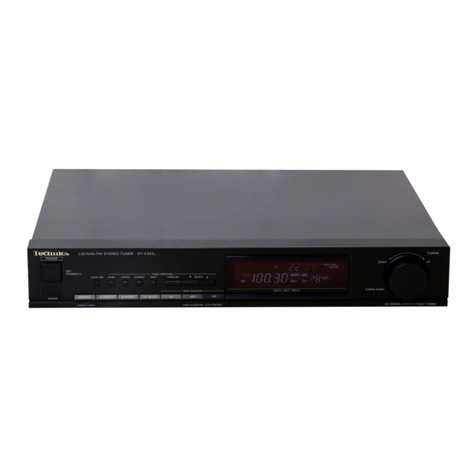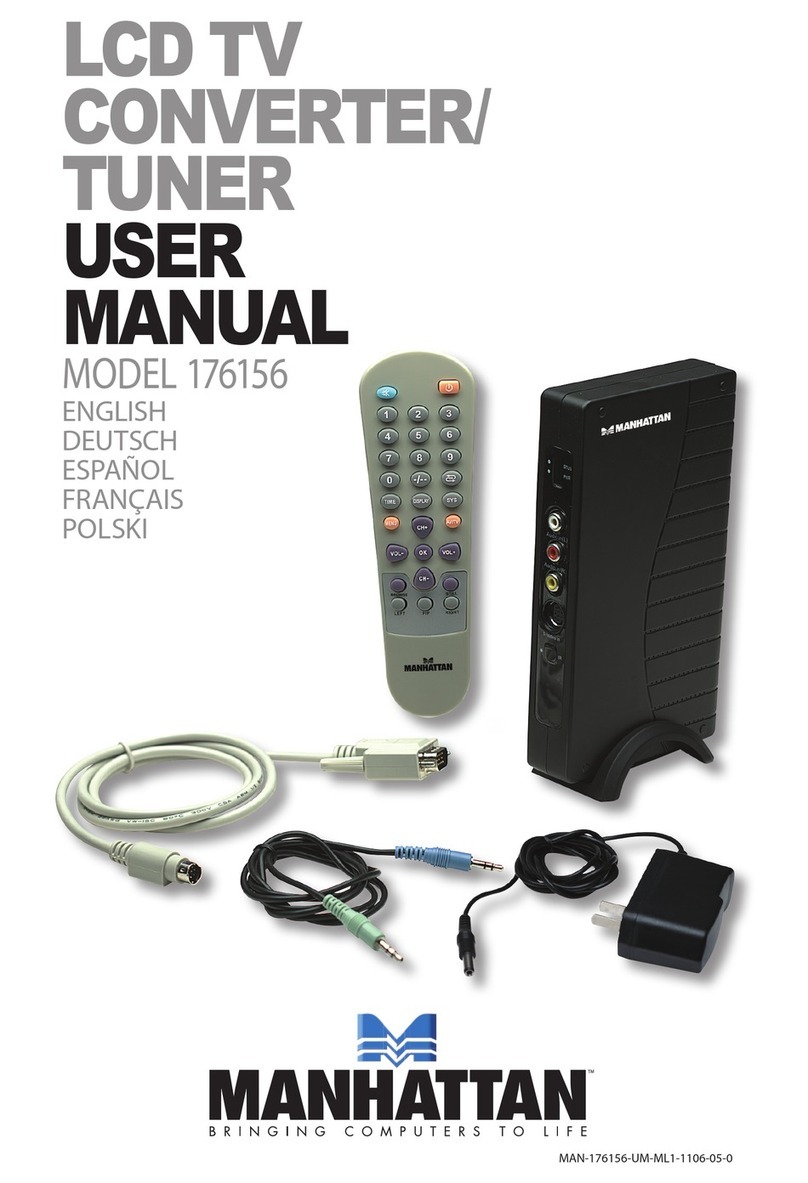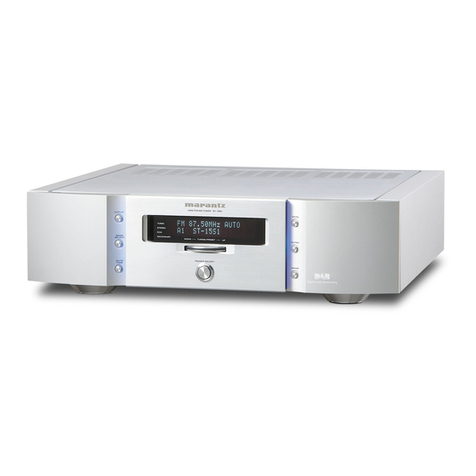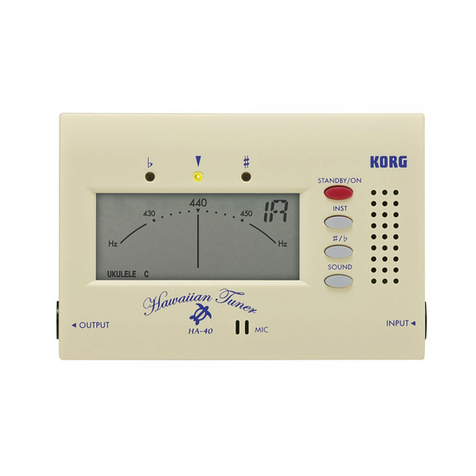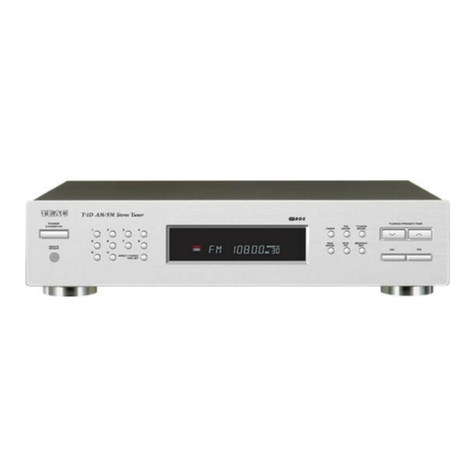Vorsicht
1Um Kurzschlüsse, elektrische Schläge oder Funktionsstörungen zu
vermeiden
Nehmen Sie das Gerät nicht auseinander und versuchen Sie nicht, es
zu reparieren.
Platzieren Sie dieses Gerät nicht an extrem heißen oder feuchten Orten
(zum Beispiel in der Nähe von Heizungen, in direktem Sonnenlicht, im
Bad oder auf einem feuchten Fußboden).
Setzen Sie dieses Gerät keinen starken Erschütterungen aus!
Platzieren Sie dieses Gerät nicht an staubigen oder schmutzigen Orten!
Bedienen Sie dieses Gerät nicht mit nassen Händen!
2Um Beschädigungen zu vermeiden
Üben Sie keine übermäßigen Druck auf die Schalter oder andere
Bedienungselemente aus.
Lassen Sie dieses Gerät nicht fallen!
3Reinigung
Verwenden Sie zum Reinigen keine Lösungsmittel, Alkohol oder andere
Reinigungsmittel.
4Um Schäden an der Batterie zu vermeiden
Nehmen Sie die Batterie heraus, wenn Sie das Gerät längere Zeit nicht
benutzen.
Merkmale und Funktionen
1POWER-Taste
Schaltet das Gerät ein und aus.
Wenn Sie das Gerät etwa zwanzig Minuten eingeschaltet
lassen, schaltet es sich automatisch aus.
2MODE-Taste
Schaltet den Tuning-Modus um. Mit jedem Drücken auf die
MODE-Taste schaltet der Tunig-Modus zwischen den
folgenden beiden Einstellungen um.
AUTO - MAN.
3FUNCTION-Taste
Wählt die Art der Einstellungen, die Sie vornehmen möchten:
PITCH, NOTE oder FLAT. (NOTE können Sie nur dann wählen, wenn
sich das Gerät im Modus MAN. (manueller Tuning-Modus) befindet.
4▲▼-Tasten
Stellen den Parameter ein, den Sie mit der FUNCTION-Taste
ausgewählt haben.
i) PITCH: Einstellung der Referenztonhöhe (Kalibrierung)
Stellt die Referenztonhöhe (A) im Bereich von 435~445
Hz ein (in Schritten von 1 Hz).
ii) NOTE: Einstellung der Note
Wählen Sie im MAN-Modus (manuell) aus den folgenden
Möglichkeiten die Note aus, die Sie stimmen möchten.
NOTE: A, A# (deutsches B), B (deutsches H), C, C#, D,
D#, E, F, F#, G, G#
iii) FLAT: Tiefalteration
Geben Sie eine Änderung relativ zur angezeigten Note an.
Sie können eine Alteration von einem bis zu fünf Halbtönen
unter der angezeigten Note einstellen.
5SOUND-Taste
Gibt einen Bezugston über den internen Lautsprecher aus.
Dadurch können Sie Ihr Instrument akustisch auf diesen
Bezugston stimmen.
Mit der FUNCTION-Taste und den
▲▼
-Tasten können Sie die
Note und die Tiefalteration für den Bezugston einstellen.
Hinweis: Bei Verwendung der SOUND-Ausgabe ist die Tonhöhe
(PITCH) auf 440 Hz festgelegt. Dies kann nicht geändert werden.
6Flüssigkristallanzeige (LCD)
* Wenn Sie das Gerät einschalten, erscheinen im LCD die
folgenden Einstellungen.
MODE = AUTO
FUNCTION = PITCH
PITCH = 440 Hz
aMODE: AUTO, MAN.
bNOTE: A, A# (deutsches B), B (deutsches H), C, C#, D,
D#, E, F, F#, G, G#
cFUNCTION: PITCH, NOTE, FLAT
d#/ : Wenn die Stimmung richtig ist, stoppt die Nadel in
der Mitte, und beide Anzeigen “ ” und “#” leuchten
auf. Die Anzeige “ ” erscheint, wenn Ihr Instrument
tiefer gestimmt ist als die angezeigte Note, die
Anzeige “#” erscheint, wenn Ihr Instrument höher
gestimmt ist.
e: Zeigt die Einstellung der Tiefalteration an. Dies zeigt
an, um wieviel tiefer die tatsächliche Stimmung Ihres
Instruments gegenüber der angezeigten Note ist.
fBezugstonhöhe: Zeigt die aktuell eingestellte
Bezugstonhöhe an.
7INPUT-Buchse
An dieser Buchse können Sie Ihr Instrument anschließen.
Wenn Sie eine E-Gitarre, eine akustisch-elektrische Gitarre oder
einen E-Bass stimmen möchten, verbinden Sie den Ausgang
Ihres Instruments mit der Eingangsbuchse INPUT des CU30.
In diesem Fall lässt sich das eingebaute Mikrofon des CU30
nicht benutzen.
8OUTPUT-Buchse
Diese Buchse gibt das Signal genauso aus, wie es empfangen
wurde. Sie können an dieser Buchse Ihren Verstärker
anschließen. Um jedoch während des Spiels Brummen oder
Rauschen zu vermeiden, schalten Sie das Stimmgerät aus.
9MICROPHONE
Bentzen Sie das interne Mikrofon, wenn Sie ein akustisches
Instrument ohne Tonabnehmer stimmen möchten, z. B. eine
akustische Gitarre.
Das eingebaute Mikro kann nicht benutzt werden, wenn ein
Stecker in der Buchse INPUT eingesteckt wurde.
0Stimm-LEDs
Die grüne LED in der Mitte leuchtet auf, wenn Ihr Instrument
auf die angezeigte Note gestimmt ist. Die rote LED links
leuchtet auf, wenn Ihr Instrument zu tief gestimmt ist, die
rote LED rechts leuchtet auf, wenn es zu hoch gestimmt ist.
Stimmen
Für präzises Stimmen beachten
•
Verwenden Sie das Stimmgerät möglichst nicht in unmittelbarer
Nähe möglicher Störquellen wie Radios oder Fernsehgeräten.
• Spielen Sie für beste Ergebnisse beim Stimmen einer E-
Gitarre oder eines E-Basses mit verringerter Lautstärke.
•
Um die jeweils nächste Saite schneller stimmen zu können,
sollten Sie zuvor nachklingende Saiten mit der Hand abdämpfen.
Automatisches Stimmen in der Betriebsart AUTO
1. Elektrische Instrumente: Verbinden Sie den Ausgang Ihres
Instruments mit der Eingangsbuchse des Stimmgerätes.
Akustische Instrumente: Benutzen Sie das eingebaute
Mikrofon.
2. Nach dem Einschalten befindet sich das CU30
automatisch im AUTO-Modus und die Tonhöhe (PITCH)
ist auf 440 Hz eingestellt.
3.
Nehmen Sie die gewünschten Einstellungen für PITCH und FLAT vor.
4. Wenn die Höhe der zu stimmenden Saite mehr als 50 Cents
von der korrekten Höhe abweicht, stimmen Sie die Saite,
bis der richtige Notenname in der Anzeige erscheint und
eine der Stimm-LEDs aufleuchtet.
Wenn die Höhe der zu stimmenden Saite weniger als 50
Cents von der korrekten Höhe abweicht, stimmen Sie die
Saite, bis die Nadel an der “0”-Stellung stoppt.
5. Wenn die Nadel des Stimmgeräts bei “0” stoppt, leuchtet
zusätzlich die grüne LED in der Mitte auf. Der
Stimmvorgang ist beendet.
Manuelles Stimmen in der Betriebsart MANUAL (MAN.)
1. Elektrische Instrumente: Verbinden Sie den Ausgang Ihres
Instruments mit der Eingangsbuchse des Stimmgerätes.
Akustische Instrumente: Benutzen Sie das eingebaute Mikrofon.
2. Nach dem Einschalten befindet sich das CU30
automatisch im AUTO-Modus und die Referenztonhöhe
(PITCH) ist auf 440 Hz eingestellt.
3.
Nehmen Sie die gewünschten Einstellungen für PITCH und FLAT vor.
4. Wählen Sie mit der MODE-Taste die Betriebsart MAN.
(manuell) aus.
Wählen Sie mit der FUNCTION-Taste die Einstellung NOTE
aus, un verwenden Sie die ▲▼-Tasten zur Auswahl der
zu stimmenden Note.
5. Wenn die Höhe der zu stimmenden Saite mehr als 50 Cents
von der korrekten Höhe abweicht, stimmen Sie die Saite,
bis der richtige Notenname in der Anzeige erscheint und
eine der Stimm-LEDs aufleuchtet.
Wenn die Höhe der zu stimmenden Saite weniger als 50
Cents von der korrekten Höhe abweicht, stimmen Sie die
Saite, bis die Nadel an der “0”-Stellung stoppt.
6. Wenn die Nadel des Stimmgeräts bei “0” stoppt, leuchtet
zusätzlich die grüne LED in der Mitte auf. Der
Stimmvorgang ist beendet.
Stimmen nach Referenzton
1. Wenn Sie die SOUND-Taste drücken, wird MODE auf MAN
eingestellt, FUNCTION auf NOTE, die NOTE-Anzeige ist
“A”, und es erklingt ein Ton in dieser Tonhöhe.
2.
Stimmen Sie Ihr Instrument nach Gehör so, dass dessen Tonhöhe
mit dem Ton aus dem Lautsprecher des CU30 übereinstimmt.
3. Ändern Sie die Einstellungen bei NOTE oder FLAT wie
gewünscht.
Einsetzen/Wechseln der Batterien
1.
Drücken Sie fest auf die Mitte
der
Batteriefachabdeckung
an der Unterseite des
Gerätes, und schieben Sie
diese in Pfeilrichtung.
2.Legen Sie zwei AAA-
Batterien mit der richtigen
Polarität ein, und setzen Sie
die Batteriefachabdeckung
wieder auf.
Technische Daten
Betriebsarten: automatisches und manuelles Stimmen (AUTO
und MAN)
Stimmbereich: A0 (27,50 Hz) ~ C8 (4.186,00 Hz)
Töne: A, A# (deutsches B), B (deutsches H), C, C#, D, D#, E,
F, F#, G, G#
Tiefalterationsmodus: 1~ 5 Halbtöne
Genauigkeit: ±1 Cent oder weniger
Kalibrierung: 435 Hz ~ 445 Hz
Anzeigen: LCD und LEDs
Eingang: Internes Mikro, INPUT-Buchse
Ausgang: Eingebauter Lautsprecher, OUTPUT-Buchse
Stromversorgung: Zwei AAA-Batterien (3 V)
Abmessungen: 105 (B) x 68 (T) x 25 (H) mm
Gewicht: 120 g (mit Batterien)
*
Ausführung und Technische Daten können sich aus Gründen
der Weiterentwicklung des Produkts ohne Ankündigung
ändern.
Attention
1Pour éviter des courts-circuits, des électrocutions ou des
dysfonctionnements :
N'essayez jamais de démonter ou réparer cet appareil.
Evitez de placer cet appareil dans des endroits soumis à
une chaleur ou une humidité excessive (p. ex. près d'un
radiateur, en plein soleil, dans une salle de bains ou sur un
sol humide).
Evitez de soumettre cet appareil à de fortes vibrations.
Evitez de placer cet appareil dans des endroits poussiéreux
ou sales.
N'utilisez pas cet appareil avec des mains humides.
2Pour éviter des dommages
N'appliquez pas trop de pression sur les commutateurs et
autres commandes.
Ne laissez pas tomber cet appareil.
3Nettoyage
N'utilisez pas de détergent, de benzène ou d'autres solvants
pour nettoyer cet appareil.
4Pour économiser la pile
Si vous n'utilisez pas cet appareil pendant une période
prolongée, retirez la pile.
Fonctions de l'accordeur
1Bouton POWER
Permet de mettre l'appareil sous/hors tension.
Si vous laissez l'appareil sous tension pendant environ 20
minutes, il se met automatiquement hors tension.
2Bouton MODE
Permet de sélectionner le mode d'accordage. Chaque fois
que vous appuyez sur le bouton MODE, le mode d'accordage
bascule entre les deux réglages suivants.
AUTO - MAN.
3Bouton FUNCTION
Permet de sélectionner le type de réglage souhaité : PITCH,
NOTE ou FLAT. (Vous ne pouvez sélectionner NOTE que si le
mode d'accordage MAN. (manuel) est défini.)
4Boutons ▲▼
Permettent de régler le paramètre sélectionné à l'aide du
bouton FUNCTION.
i) PITCH : Réglage du diapason de référence (calibrage)
Réglez le diapason de référence (A) dans une plage de
435 à 445 Hz (par pas de 1 Hz).
ii) NOTE : Réglage de la note
En mode MAN. (manuel), sélectionnez la note à accorder
à partir des options suivantes.
NOTE : A (la), A#, B (si), C (do), C#, D (ré), D#, E (mi), F (fa),
F#, G (sol), G#
iii) FLAT : Réglage bémol
Spécifiez un
accordage
plus bas par rapport à la note
affichée. Vous pouvez sélectionner un
accordage
d'un à
cinq demi-tons plus bas que la note affichée.
5Bouton SOUND
Permet de reproduire un accordage de référence à partir du haut-
parleur interne. Vous pouvez régler un accordage tout en
comparant la sortie de votre instrument à l'accordage de référence.
Vous pouvez utiliser les boutons FUNCTION et▲▼ pour spécifier
la note et le réglage plus bas pour l'accordage de référence.
Remarque : Lorsque vous utilisez la sortie SOUND, le réglage
PITCH est défini sur 440 Hz. Vous ne pouvez pas le modifier.
6Ecran à cristaux liquides (LCD)
* Lorsque vous mettez l'appareil sous tension, l'écran LCD
affiche les réglages suivants.
MODE = AUTO
FUNCTION = PITCH
PITCH = 440 Hz.
aMODE : AUTO, MAN.
bNOTE : A (la), A#, B (si), C (do), C#, D (ré), D#, E (mi), F (fa),
F#, G (sol), G#
cFUNCTION : PITCH, NOTE, FLAT
d
#/ : Lorsque l'accordage est correct, l'aiguille s'arrête au
milieu de l'écran et les indications " " et "#" s'affichent.
L'indication " " s'affiche si la note est plus basse que
la note affichée. L'indication "#" s'affiche si la note est
plus haute.
e: Indique que le réglage de l'accordage est trop bas.
Vous pouvez ainsi savoir si la tonalité réelle de votre
instrument est trop basse par rapport à la note affichée.
fDiapason de référence : Indique le diapason de référence
actuellement spécifié.
7Prise INPUT
Vous pouvez brancher votre instrument à cette prise d'entrée.
Si vous accordez une guitare électrique, électro-acoustique
ou une basse électrique, branchez la sortie de votre instru-
ment à la prise INPUT du CU30.
Toutefois, dans ce cas, vous ne pouvez pas utiliser le micro-
phone interne du CU30.
Caution
1To avoid short circuit, electric shock, or malfunction
Do not disassemble or attempt to repair this unit.
Do not place this unit in locations of high temperature or
high humidity (such as nearby heating equipment, in direct
sunlight, in a bathroom, or on a wet floor).
Do not place this unit where it will be subjected to heavy
vibration.
Do not place this unit in dusty or dirty locations.
Do not operate this unit with wet hands.
2To avoid damage
Do not apply excessive force to the switches or other con-
trols.
Do not drop this unit.
3Cleaning
Do not use thinner, alcohol, or other solvents to clean this
unit.
4To prevent battery failure
Remove the battery if you won't be using this unit for an
extended time.
Features & Functions
1POWER button
Turns the power on/off.
If you leave the power turned on for approximately twenty
minutes, it will turn off automatically.
2MODE button
Switches the tuning mode. Each time you press the MODE
button, the tuning mode will cycle between the following two
settings.
AUTO - MAN.
3FUNCTION button
Selects the type of adjustment you want to make: PITCH,
NOTE, or FLAT. (You can select NOTE only if you're in MAN.
(manual) tuning mode.)
4▲▼ buttons
Adjust the parameter you've selected using the FUNCTION
button.
i) PITCH: Reference pitch setting (calibration)
Adjust the reference pitch (A) in the range of 435~445 Hz
(1 Hz steps).
ii) NOTE: Note setting
When in MAN. (manual) mode, select the note to which
you want to tune, from the following choices.
Note :A, A#, B, C, C#, D, D#, E, F, F#, G, G#
iii) FLAT: Flat setting
Specify a flatted tuning relative to the displayed note. You
can tune to a flatted tuning from one to five semitones
below the displayed note.
5SOUND button
Sounds a reference tone from the internal speaker. This lets
you tune while comparing the output of your instrument to
the reference tone.
You can use the FUNCTION button and the ▲▼ buttons to
specify the note and flatted setting for the reference tone.
Note) When using the SOUND output, the PITCH is fixed at
440 Hz. This cannot be changed.
6Liquid Crystal Display (LCD)
* When you turn the power on, the LCD will show the follow
ing settings.
MODE = AUTO
FUNCTION = PITCH
PITCH = 440 Hz
aMODE: AUTO, MAN.
bNOTE: A, A#, B, C, C#, D, D#, E, F, F#, G, G#
cFUNCTION: PITCH, NOTE, FLAT
d#/ : When the tuning is correct, the needle will stop in
the center, and the " " and "#" indications will both
appear. The " " indication appears if your instrument
is flatter than the displayed note, and the "#"
indication appears if your instrument is sharper.
e: Indicates the flatted tuning setting. This indicates how
much lower the actual pitch of your instrument is
compared to the displayed note.
fReference pitch: Indicates the currently-specified
reference pitch.
gTuning meter
When the string is in tune, Tuning needle stops in the cen-
ter “0”.
7INPUT jack
You can connect your instrument to this input jack.
If you're tuning an electric guitar, acoustic-electric guitar, or
electric bass, connect the output of your instrument to the
CU30's INPUT jack.
However in this case, you won't be able to use the CU30's
internal mic.
8OUTPUT jack
This jack directly outputs the signal that is being input. You
can connect this jack to your amp. However to prevent hum
or other noise while you're performing, turn off the power of
the tuner.
9MICROPHONE
Use the internal mic when you want to tune an instrument
that has no pickup, such as an acoustic guitar.
However, the internal mic cannot be used if a plug is inserted
in the INPUT jack.
0Tuning guide LEDs
The green LED in the center will light when your instrument
matches the displayed note. The red LED at the left will light
if your instrument is flat, and the red LED at the right will
light if your instrument is sharp.
Tuning Procedure
For accurate tuning
• Don't use this tuner near sound equipment such as ra-
dios or televisions.
• When tuning an electric guitar/bass, use a moderate vol-
ume for best tuning results.
• In order to tune strings faster, mute all strings by hand
after you've finished tuning each string.
Tuning in Auto mode
1. Electric instruments: Connect the output of your
instrument to the input jack of the tuner.
Acoustic instruments: Use the internal mic.
2. When you turn on the power, the CU30 is automatically
set to MODE=AUTO and PITCH=440 Hz.
3. Change the PITCH and FLAT settings if desired.
4. If the pitch of the string is more than ±50 cents away
from the correct pitch, tune the string until the correct
note name appears in the LCD and one of the tuning
guide LEDs is lit.
When the pitch of the string is within ± 50 cents of the
correct pitch, tune the string to make the needle stop at
the “0” position.
5. When the tuner needle stops at "0," the green LED in the
center will light. Tuning is complete.
Tuning in Manual mode
1. Electric instruments: Connect the output of your
instrument to the input jack of the tuner.
Acoustic instruments: Use the internal mic.
2. When you turn on the power, the CU30 is automatically
set to MODE=AUTO and PITCH=440 Hz.
3. Change the PITCH and FLAT settings if desired.
4. Use the MODE button to select MAN. (manual).
Use the FUNCTION button to select NOTE, and use the
▲▼ buttons to select the note that you want to tune.
5. If the pitch of the string is more than ±50 cents away
from the correct pitch, tune the string until the correct
note name appears in the LCD and one of the tuning guide
LEDs is lit.
When the pitch of the string is within ±50 cents of the
correct pitch, tune the string to make the needle stop at
the "0" position.
6. When the tuner needle stops at "0," the green LED in the
center will light. Tuning is complete.
Tuning by Sound
1. When you press the SOUND button, MODE will be set to
MAN., FUNCTION will be set to NOTE, the NOTE indica-
tion will be A, and that pitch will be sounded.
2. Tune your instrument to match the pitch you hear from
the CU30's internal speaker.
3. Change the NOTE or FLAT settings accordingly.
Installing/replacing the batteries
1. Firmly press the center of the
battery cover located on the
bottom of the unit, and slide
it in the direction of the ar-
row.
2.Insert two AAA batteries in
the correct polarity, and re-
place the battery cover.
Specifications
Modes: Auto Tuning and Manual Tuning modes
Tuning range: A0 (27.50 Hz) ~ C8 (4,186.00 Hz)
Tuning notes: A, A#, B, C, C#, D, D#, E, F, F#, G, G#
Flat tuning: 1~5 semitones
Accuracy: ±1 cent or less
Calibration: 435 Hz ~ 445 Hz
Indicators: LCD and LEDs
Input: Internal mic, INPUT jack
Output: Internal speaker, OUTPUT jack
Power supply: Two AAA batteries (3V)
Dimensions: 105 (W) x 68 (D) x 25 (H) mm
Weight: 120 g (including batteries)
* Design and specifications are subject to change without
notice for improvement of the product.
This is to certify that Chromatic Tuner CU30 is in conformity with
: Council Directive 89/336/EEC (EMC Directive)
Applicable Standards :
EN55013 : 2001 + A1 : 2003
Electromagnetic Compatibility-Generic emission standard.
Part 1 :
Residential, commercial and light industry.
EN55020 : 2002 + A1 : 2003
Electromagnetic Compatibility-Generic immunity standard.
Part 1 :
Residential, commercial and light industry.
CHROMATIC TUNER
CU30
OWNER’S MANUAL
Par la présente, nous certifions que l’accordeur chromatique CU30 se
conforme à: Directive du Conseil 89/336/EEC (directive EMC)
Normes étant d’application :
EN55013 : 2001 + A1 : 2003
Compatibilité électromagnétique – norme générale d’émission.
Partie 1:
Résidentiel, commercial, industrie légère.
EN55020 : 2002 + A1 : 2003
Compatibilité électromagnétique – norme générale d’immunité.
Partie 1:
Résidentiel, commercial, industrie légère.
ACCORDEUR CHROMATIQUE
CU30
MANUEL DE I'UTILISATEUR
Hiermit wird die Konformität des Chromatisches stimmgerät CU30
mit der EU-Richtlinie 89/336/EEC bestätigt.
Relevante Vorschriften:
EN55013 : 2001 + A1 : 2003
Elektromagnetische Kompatibilität – allgemeiner Emissionsvorschriften.
Teil 1:
Haushaltsgeräte, gewerbliche und leichtindustrielle Ausrüstung.
EN55020 : 2002 + A1 : 2003
Elektromagnetische Kompatibilität – allgemeine Verträglichkeitsvorschriften.
Teil 1:
Haushaltsgeräte, gewerbliche und leichtindustrielle Ausrüstung.
CHROMATISCHES STIMMGERÄT
CU30
BEDIENUNGSANLEITUNG
8Prise OUTPUT
Cette prise retransmet directement le signal de l'instrument.
Vous pouvez brancher votre amplificateur à cette prise.
Veillez toutefois à mettre l'accordeur hors tension pour éviter
les bourdonnements ou autres bruits pendant que vous
jouez.
9MICROPHONE
Utilisez le microphone interne lorsque vous souhaitez
accorder un instrument sans micro comme une guitare
acoustique.
Vous ne pouvez toutefois pas utiliser le microphone interne
si un instrument est branché à la prise INPUT.
0Témoins de référence pour l'accordage
Le témoin vert au centre s'allume lorsque la note correspond
à la note affichée. Si la note est trop basse, le témoin rouge
de gauche s'allume. Si elle est trop haute, le témoin rouge
de droite s'allume.
Procédure d'accordage
Pour accorder votre instrument avec précision
• Evitez d'utiliser cet accordeur à proximité d'un poste de
radio ou de télévision.
• Lorsque vous accordez une guitare/basse électrique,
réglez le volume de façon modérée pour obtenir un
accordage précis.
• Pour accorder les cordes plus vite, atténuez le son de
toutes les cordes avec la main après avoir accordé
chacune d'elles.
Accordage en mode automatique
1. Instruments électriques : Branchez la sortie de votre in-
strument à la prise d'entrée de l'accordeur.
Instruments acoustiques : Utilisez le microphone interne.
2. Lorsque vous mettez le CU30 sous tension, il sélectionne
automatiquement MODE=AUTO et PITCH=440 Hz.
3. Modifiez les réglages PITCH et FLAT le cas échéant.
4. Si la tonalité de la corde est supérieure à ±50 cents par
rapport à la tonalité juste, accordez la corde jusqu'à ce
que le nom de la note correcte s'affiche sur l'écran LCD
et que l'un des témoins s'allume.
Lorsque la tonalité de la corde se trouve à moins de ±50
cents de la tonalité correcte, accordez la corde jusqu'à
ce que l'aiguille s'arrête sur la position "0".
5. Lorsque l'aiguille de l'accordeur s'arrête sur "0", le témoin
vert au milieu s'allume. L'accordage est terminé.
Accordage en mode manuel
1. Instruments électriques : Branchez la sortie de votre in-
strument à la prise d'entrée de l'accordeur.
Instruments acoustiques : Utilisez le microphone interne.
2. Lorsque vous mettez le CU30 sous tension, il sélectionne
automatiquement MODE=AUTO et PITCH=440 Hz.
3. Modifiez les réglages PITCH et FLAT le cas échéant.
4. Le bouton MODE permet de sélectionner MAN. (manuel).
Le bouton FUNCTION permet de sélectionner NOTE. Les
boutons ▲▼ permettent de sélectionner la note à
accorder.
5. Si la tonalité de la corde est supérieure à ±50 cents par
rapport à la tonalité juste, accordez la corde jusqu'à ce
que le nom de la note correcte s'affiche sur l'écran LCD
et que l'un des témoins s'allume.
Lorsque la tonalité de la corde se trouve à moins de ±50
cents de la tonalité correcte, accordez la corde jusqu'à
ce que l'aiguille s'arrête sur la position "0".
6. Lorsque l'aiguille de l'accordeur s'arrête sur "0", le témoin
vert au milieu s'allume. L'accordage est terminé.
Accordage avec notes pilotes
1. Lorsque vous appuyez sur le bouton SOUND, MODE est
défini sur MAN., FUNCTION est défini sur NOTE, NOTE
indique A et la tonalité sélectionnée retentit.
2. Accordez votre instrument selon la tonalité qui retentit du
haut-parleur interne du CU30.
3. Modifiez les réglages NOTE ou FLAT en conséquence.
Installation/remplacement des piles
1.Appuyez fermement sur le
centre du couvercle des
piles situé au dos de
l'appareil et faites-le glisser
dans le sens de la flèche.
2. Insérez deux piles de type
AAA dans le bon sens et
replacez le couvercle.
Fiche technique
Modes : Accordage automatique et Accordage manuel
Fréquences reconnues : A0 (27,50 Hz) ~ C8 (4 186 Hz)
Notes d'accordage :A (la), A#, B (si), C (do), C#, D (ré), D#,
E (mi), F (fa), F#, G (sol), G#
Accordage bémol : 1~5 demi-tons
Précision : ±1 cent ou moins
Calibrage : 435 Hz ~ 445 Hz
Témoins : écran LCD et témoins
Entrée : microphone interne, prise INPUT
Sortie : haut-parleur interne, prise OUTPUT
Alimentation : deux piles de type AAA (3V)
Dimensions : 105 (L) x 68 (P) x 25 (H) mm
Poids : 120 g (piles comprises)
*Les caractéristiques et la présentation sont susceptibles
d'être modifiées sans avis préalable pour l'amélioration du
produit.
